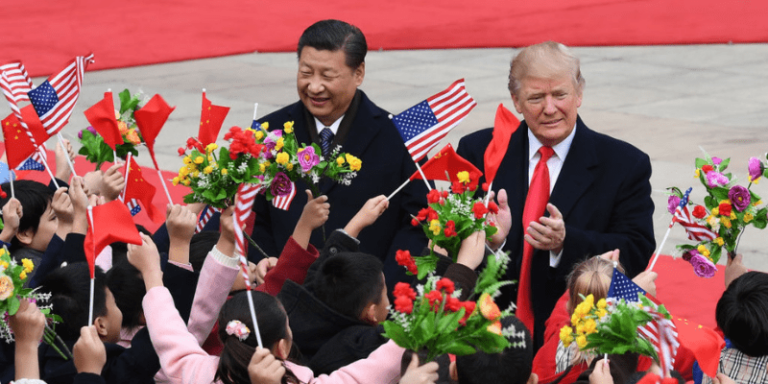The Spill: China Deal
Weekly news you can use.
By: GenZ Staff | January 21, 2020 | 868 Words

(Xinhua/Rao Aimin via Getty Images)
Senate Trial Starting on Trump Impeachment
A Senate trial of President Donald Trump begins this week.
The House of Representatives recently impeached the president over claims that he had an improper phone call with the president of Ukraine. The next stage of the process is a trial in the Senate to decide whether the president is guilty or innocent of the accusations against him. Senators will act as a jury in the trial, with Democrats expected to vote against Trump, while most Republicans are expected to vote in his favor.
House Speaker Nancy Pelosi (D-CA) sent the articles of impeachment to the upper chamber last week and assigned seven Democrat impeachment managers to act as prosecutors. Now, the Senate has decided the rules of the trial.
Senate Majority Leader Mitch McConnell (R-KY) wrote a Senate Resolution setting out rules. He suggests that each side should be given 24 hours in which to present its case, followed by 16 hours of questions that should be sent to Supreme Court Chief Justice Roberts in advance. Roberts is acting as the overseer of the trial.
Democratic Party politicians were not happy with McConnell’s resolution. The disagreement was about McConnell’s proposal that the 24-hour presentation stage should take place over two days. Democrats suggest this is not enough time and would force Senators to conduct the trial late at night. Members of the Senate debate late into the night about the rules; in the end, it was agreed to extend the presentation time over three days.
After the allotted period for each side to present their arguments and questions, senators will vote on whether witnesses should be called. If a majority votes to call witnesses, the trial will be extended; if not, a final vote will take place on whether or not to convict President Trump.
China Trade Deal
The U.S.-China trade war may be over as the two countries have finally signed phase one of a trade deal. When President Trump was elected, he took a hard stance against what he said were unfair trading terms with China. He claimed the Asian superpower was taking advantage of weak U.S. policies. He placed tariffs (taxes) on Chinese goods, and it has taken 18 months for the two governments to work out an agreement. Trump promised that the deal delivers “economic justice” for American workers, farmers, and families that “should have happened 25 years ago.”
Trump stated the partnership will remove “market barriers” to energy, manufacturing, retail, agriculture, and other industries. He announced that all tariffs on China would come off once the second phase of the agreement is complete.
 Chinese Vice Premier Liu He traveled to the White House to sign the deal. He called phase one a win-win deal that “will bring stable economic growth, promote world peace and prosperity, and is in the interest of consumers and investors of both countries.”
Chinese Vice Premier Liu He traveled to the White House to sign the deal. He called phase one a win-win deal that “will bring stable economic growth, promote world peace and prosperity, and is in the interest of consumers and investors of both countries.”
China has agreed to spend $200 billion over the next two years on U.S. agriculture, food, seafood products, and financial services. It will also reform its policies relating to finance, intellectual property, and technology.
In return, the U.S. will cut in half a 15% tax on $110 billion worth of imports.
Trump tweeted on December 31 that he would eventually travel to the Chinese capital city, Beijing, to help start the second phase of talks.
School Lunch Rule Change
It often seems like people are forced to choose between a healthy lunch, or one that tastes good – how important is nutrition when it comes to meals at school?
The United States Department of Agriculture (USDA) announced that it will relax the rules when it comes to nutrition in school meals and summer programs. “Schools and school districts continue to tell us that there is still too much food waste and that more common-sense flexibility is needed to provide students nutritious and appetizing meals,” said Agriculture Secretary Sonny Perdue.
The current rules were designed to promote healthy eating by increasing the fruits, vegetables, and whole grains in students’ diets while reducing the salt, fat, and sugar. Gay Anderson, president of the School Nutrition Association, said that although the nutrition rules had been positive overall, some of the requirements had resulted in lower student participation, higher costs, and increased waste, as kids did not always eat the food served to them.
The proposal will give more control to local officials who will be able to make changes such as:
- Reduce the amount of certain vegetables that would have to be served every day at lunch.
- To-go breakfast servings of fruit could be reduced.
- Potatoes could be served as a vegetable.
- Legumes given as a meat alternative could count towards vegetable portions.
Not everyone is impressed by the change. The American Heart Association said the rule would “put children’s health at risk.” The organization added, “Healthy school meals help combat childhood obesity and poor cardiovascular health, but they also help establish a foundation for a lifetime of healthy behaviors.”
The school meals program currently serves 30 million pupils across the U.S., while the summer food service has 2.6 million participants.
What would you choose to have for lunch? What can schools and families do to create meals that are both tasty and healthy?

















